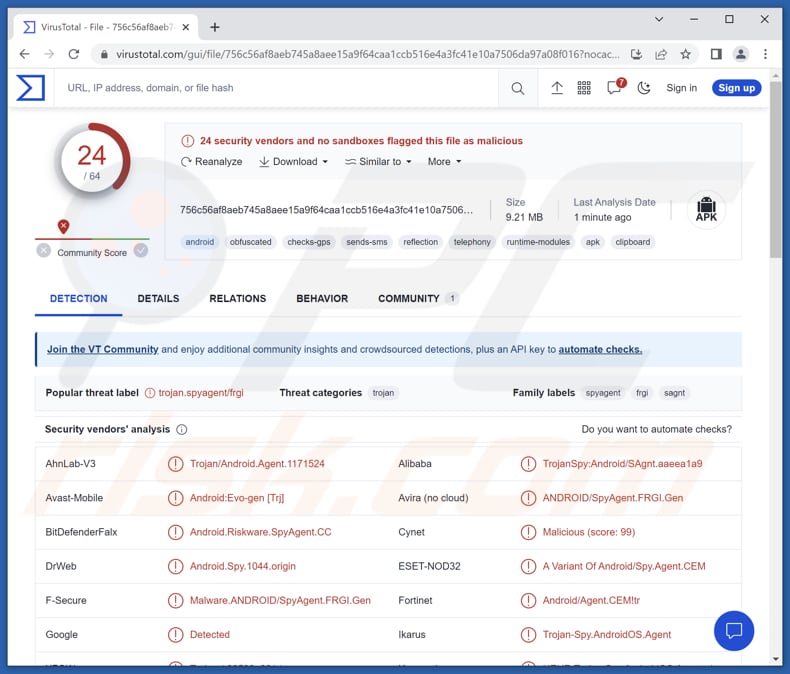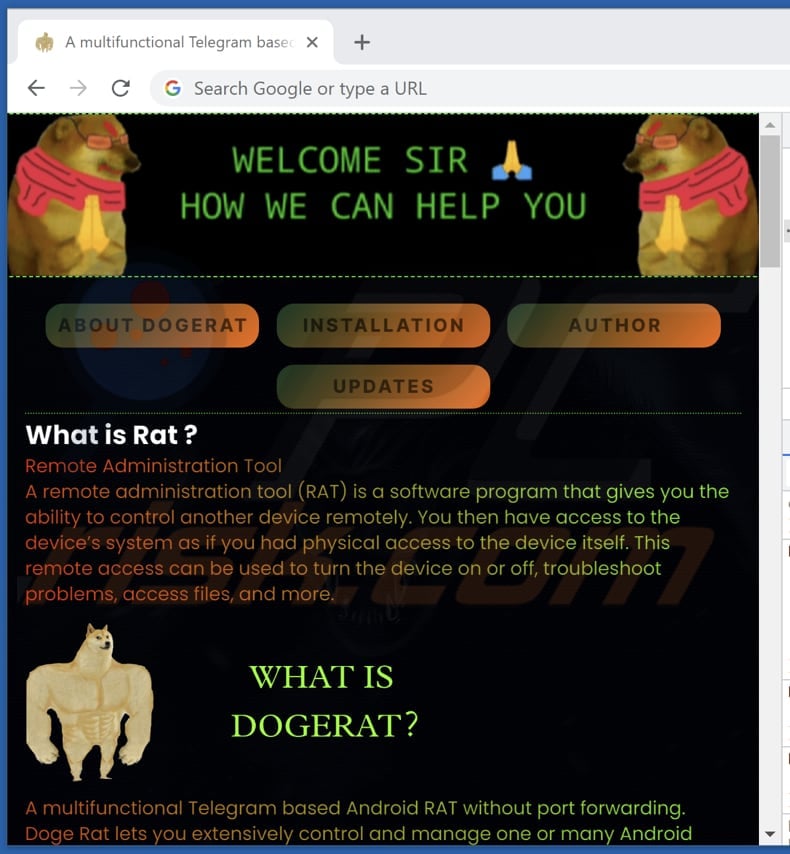How to remove DogeRAT from Android device
![]() Written by Tomas Meskauskas on (updated)
Written by Tomas Meskauskas on (updated)
What kind of malware is DogeRAT?
DogeRAT is an Android malware known as a Remote Access Trojan (RAT) that operates under an open-source framework. It masquerades as a legitimate application and is being circulated through social media platforms and messaging apps.
Threat actors behind DogeRAT focus on a broad range of industries, with a particular interest in targeting customers in the Banking and Entertainment sectors.

DogeRAT overview
Upon its initial execution, DogeRAT obtains various permissions, including but not limited to accessing call logs, recording audio, and reading SMS messages, media files, and photos, among others. Once installed, DogeRAT can extract sensitive data from a device, including contacts, messages, and banking credentials.
It can also provide threat actors with control over the device, enabling them to carry out nefarious activities such as sending spam messages, modifying files, accessing call records, reading notifications, obtaining a list of installed apps, and even capturing photos using the compromised device's front and rear cameras.
DogeRAT is being promoted by the developer in at least two Telegram channels. The premium version of DogeRAT includes enhanced features such as screenshot capture, gallery image theft, keylogging functionality, clipboard information theft, an upgraded file manager, improved persistence, and seamless bot connections with the infected device.
| Name | DogeRAT Remote Access Trojan |
| Threat Type | Android malware, Remote Access Trojan (RAT) |
| Detection Names | Avast-Mobile (Android:Evo-gen [Trj]), BitDefenderFalx (Android.Riskware.SpyAgent.CC), ESET-NOD32 (A Variant Of Android/Spy.Agent.CEM), Kaspersky (HEUR:Trojan-Spy.AndroidOS.Agent.abx), Microsoft (Trojan:Script/Wacatac.B!ml), Full List Of Detections (VirusTotal) |
| Symptoms | The device is running slow, system settings are modified without user's permission, questionable applications appear, data and battery usage is increased significantly, browsers redirect to questionable websites, and similar symptoms |
| Distribution methods | Fake applications promoted via social media and messaging apps |
| Damage | Stolen personal information (private messages, logins/passwords, etc.), decreased device performance, battery is drained quickly, decreased Internet speed, huge data losses, monetary losses, stolen identity, and more |
| Malware Removal (Android) | To eliminate possible malware infections, scan your mobile device with legitimate antivirus software. Our security researchers recommend using Combo Cleaner. |
Possible damage
Victims of DogeRAT face potential damages, including data theft (contacts, messages, banking credentials), unauthorized control over the device (spam messages, file modifications), privacy breaches (capturing photos without consent), and the premium version offers even more malicious features (screenshot capture, keylogging, etc.).
These damages can lead to financial loss, reputational harm, compromised personal information, and more. A couple examples of other Android malware with similar capabilities are Pekka, AhRat, and Gigabud.
How did DogeRAT infiltrate my device?
DogeRAT is distributed through social media and messaging apps, where it is disguised as legitimate applications such as YouTube Premium, SeoSprint, Zetflix, Petcoa, Telegram Premium, or another app. This means that cybercriminals promote the RAT by masquerading it as a well-known and trusted app, tricking users into downloading and installing it.
The distribution channels utilized by the attackers enable them to reach a large audience and increase the likelihood of successful infections.
How to avoid installation of malware?
Download apps only from trusted sources such as the Google Play Store or official websites. Avoid downloading apps from third-party or unverified sources, and read reviews before downloading apps. Enable the "Verify apps" feature on your device, which scans apps for potential threats before installation.
Keep your Android operating system and apps up to date with the latest security patches. Regularly check for updates and install them right away. Be cautious when granting permissions to apps. Review the permissions requested by each app before installation and only provide necessary permissions.
Website promoting DogeRAT:

Quick menu:
- Introduction
- How to delete browsing history from the Chrome web browser?
- How to disable browser notifications in the Chrome web browser?
- How to reset the Chrome web browser?
- How to delete browsing history from the Firefox web browser?
- How to disable browser notifications in the Firefox web browser?
- How to reset the Firefox web browser?
- How to uninstall potentially unwanted and/or malicious applications?
- How to boot the Android device in "Safe Mode"?
- How to check the battery usage of various applications?
- How to check the data usage of various applications?
- How to install the latest software updates?
- How to reset the system to its default state?
- How to disable applications that have administrator privileges?
Delete browsing history from the Chrome web browser:

Tap the "Menu" button (three dots on the right-upper corner of the screen) and select "History" in the opened dropdown menu.

Tap "Clear browsing data", select "ADVANCED" tab, choose the time range and data types you want to delete and tap "Clear data".
Disable browser notifications in the Chrome web browser:

Tap the "Menu" button (three dots on the right-upper corner of the screen) and select "Settings" in the opened dropdown menu.

Scroll down until you see "Site settings" option and tap it. Scroll down until you see "Notifications" option and tap it.

Find the websites that deliver browser notifications, tap on them and click "Clear & reset". This will remove permissions granted for these websites to deliver notifications. However, once you visit the same site again, it may ask for a permission again. You can choose whether to give these permissions or not (if you choose to decline the website will go to "Blocked" section and will no longer ask you for the permission).
Reset the Chrome web browser:

Go to "Settings", scroll down until you see "Apps" and tap it.

Scroll down until you find "Chrome" application, select it and tap "Storage" option.

Tap "MANAGE STORAGE", then "CLEAR ALL DATA" and confirm the action by taping "OK". Note that resetting the browser will eliminate all data stored within. This means that all saved logins/passwords, browsing history, non-default settings and other data will be deleted. You will also have to re-login into all websites as well.
Delete browsing history from the Firefox web browser:

Tap the "Menu" button (three dots on the right-upper corner of the screen) and select "History" in the opened dropdown menu.

Scroll down until you see "Clear private data" and tap it. Select data types you want to remove and tap "CLEAR DATA".
Disable browser notifications in the Firefox web browser:

Visit the website that is delivering browser notifications, tap the icon displayed on the left of URL bar (the icon will not necessarily be a "Lock") and select "Edit Site Settings".

In the opened pop-up opt-in the "Notifications" option and tap "CLEAR".
Reset the Firefox web browser:

Go to "Settings", scroll down until you see "Apps" and tap it.

Scroll down until you find "Firefox" application, select it and tap "Storage" option.

Tap "CLEAR DATA" and confirm the action by taping "DELETE". Note that resetting the browser will eliminate all data stored within. This means that all saved logins/passwords, browsing history, non-default settings and other data will be deleted. You will also have to re-login into all websites as well.
Uninstall potentially unwanted and/or malicious applications:

Go to "Settings", scroll down until you see "Apps" and tap it.

Scroll down until you see a potentially unwanted and/or malicious application, select it and tap "Uninstall". If, for some reason, you are unable to remove the selected app (e.g., you are prompted with an error message), you should try using the "Safe Mode".
Boot the Android device in "Safe Mode":
The "Safe Mode" in Android operating system temporarily disables all third-party applications from running. Using this mode is a good way to diagnose and solve various issues (e.g., remove malicious applications that prevent users you from doing so when the device is running "normally").

Push the "Power" button and hold it until you see the "Power off" screen. Tap the "Power off" icon and hold it. After a few seconds the "Safe Mode" option will appear and you'll be able run it by restarting the device.
Check the battery usage of various applications:

Go to "Settings", scroll down until you see "Device maintenance" and tap it.

Tap "Battery" and check the usage of each application. Legitimate/genuine applications are designed to use as low energy as possible in order to provide the best user experience and to save power. Therefore, high battery usage may indicate that the application is malicious.
Check the data usage of various applications:

Go to "Settings", scroll down until you see "Connections" and tap it.

Scroll down until you see "Data usage" and select this option. As with battery, legitimate/genuine applications are designed to minimize data usage as much as possible. This means that huge data usage may indicate presence of malicious application. Note that some malicious applications might be designed to operate when the device is connected to wireless network only. For this reason, you should check both Mobile and Wi-Fi data usage.

If you find an application that uses a lot of data even though you never use it, then we strongly advise you to uninstall it as soon as possible.
Install the latest software updates:
Keeping the software up-to-date is a good practice when it comes to device safety. The device manufacturers are continually releasing various security patches and Android updates in order to fix errors and bugs that can be abused by cyber criminals. An outdated system is way more vulnerable, which is why you should always be sure that your device's software is up-to-date.

Go to "Settings", scroll down until you see "Software update" and tap it.

Tap "Download updates manually" and check if there are any updates available. If so, install them immediately. We also recommend to enable the "Download updates automatically" option - it will enable the system to notify you once an update is released and/or install it automatically.
Reset the system to its default state:
Performing a "Factory Reset" is a good way to remove all unwanted applications, restore system's settings to default and clean the device in general. However, you must keep in mind that all data within the device will be deleted, including photos, video/audio files, phone numbers (stored within the device, not the SIM card), SMS messages, and so forth. In other words, the device will be restored to its primal state.
You can also restore the basic system settings and/or simply network settings as well.

Go to "Settings", scroll down until you see "About phone" and tap it.

Scroll down until you see "Reset" and tap it. Now choose the action you want to perform:
"Reset settings" - restore all system settings to default;
"Reset network settings" - restore all network-related settings to default;
"Factory data reset" - reset the entire system and completely delete all stored data;
Disable applications that have administrator privileges:
If a malicious application gets administrator-level privileges it can seriously damage the system. To keep the device as safe as possible you should always check what apps have such privileges and disable the ones that shouldn't.

Go to "Settings", scroll down until you see "Lock screen and security" and tap it.

Scroll down until you see "Other security settings", tap it and then tap "Device admin apps".

Identify applications that should not have administrator privileges, tap them and then tap "DEACTIVATE".
Frequently Asked Questions (FAQ)
My computer is infected with DogeRAT malware, should I format my storage device to get rid of it?
Before resorting to formatting, it is recommended to try using reputable antivirus or anti-malware software to scan and remove the malware. These security tools can often detect and eliminate malware effectively.
What are the biggest issues that malware can cause?
Having a device infected with malware can result in the theft of sensitive personal or financial information, leading to identity theft or monetary loss. Additionally, malware can disrupt computer systems, leading to data loss, system crashes, and compromised network security, which can seriously affect businesses and individuals.
What is the purpose of DogeRAT?
The purpose of DogeRAT is to act as a Remote Access Trojan (RAT) that provides unauthorized remote access and control over infected devices. It is designed to steal sensitive information, such as personal data, contacts, messages, and banking credentials, from the compromised device. Additionally, it allows threat actors to carry out various malicious activities, including sending spam messages, modifying files, and even capturing photos using the device's cameras.
How did DogeRAT infiltrate my device?
DogeRAT can infiltrate devices through various channels, including social media, messaging apps, and potentially malicious websites. It is often disguised as a legitimate app.
Will Combo Cleaner protect me from malware?
Combo Cleaner has the ability to detect and remove the majority of known malware. However, it is important to note that sophisticated malware often conceals itself deeply within the system. Therefore, a complete system scan is essential to identify and eliminate hidden threats.


▼ Show Discussion